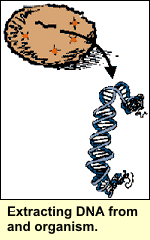The process of genetic engineering requires the successful completion of a series of five steps and discoveries. To better understand each of these, the development of Bt corn will be used as an example.
Before the genetic engineering process can begin, a living organism that exhibits the desired trait must be discovered.  The trait for Bt corn (resistance to European corn borer) was actually discovered around 100 years ago. Silk worm farmers in the Orient had noticed that populations of silk worms were dying. Scientists discovered that a naturally occurring soil bacteria was causing the silk worm deaths. These soil bacteria, called Bacillus thuringiensis, or Bt for short, produced a protein that was toxic to silk worms,the Bt protein. The trait for Bt corn (resistance to European corn borer) was actually discovered around 100 years ago. Silk worm farmers in the Orient had noticed that populations of silk worms were dying. Scientists discovered that a naturally occurring soil bacteria was causing the silk worm deaths. These soil bacteria, called Bacillus thuringiensis, or Bt for short, produced a protein that was toxic to silk worms,the Bt protein.
Although the scientists didn't know it, they had made one of the first discoveries necessary in the process of making Bt corn. The same Bt protein found to be toxic to silk worms is also toxic to European corn borer because both insects belong to the Lepidoptera order. The production of the Bt protein in the Bt soil bacteria is controlled by the soil bacteria's DNA.
In order to be able to work with the DNA, scientists have to extract it out of the soil bacteria. DNA extraction is the first step in the genetic engineering process. This is accomplished by taking a sample of bacteria containing the gene of interest and taking it through a series of steps that separate the DNA from the other parts of a cell.
 | 








